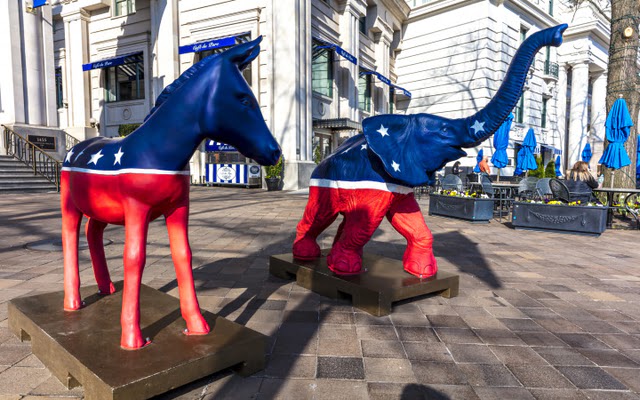Quck answer
Political symbols come from a variety of sources, including historical events, cultural traditions, and ideological beliefs. They often represent ideas, values, and movements associated with a particular political group or ideology. Some symbols, such as flags and national anthems, are widely recognized and used to represent entire countries. Others, like party logos or emblems, are specific to individual political parties or organizations. Symbols can also evolve over time, adapting to changing political landscapes and societal norms. They serve as powerful visual tools, capable of conveying complex messages and inspiring emotional connections. Overall, political symbols play a crucial role in shaping political identity and mobilizing support for different causes.

Before we discuss the mascots of political parties, let’s gain some knowledge about political parties in general.
A political party is a group of organized voters who advocate for specific policies that benefit their communities, states, and country.
The main objective of a political party is to elect public officials, such as mayors, governors, senators, and the president, who will support and implement their goals. These goals may include policies on war, taxes, and education.
In a democracy, when people have differing opinions on what the government should do, registered voters express their views by voting for the candidate who aligns most closely with their political beliefs and opinions. These candidates are usually affiliated with political parties.
By being associated with a political party, voters can easily understand the candidate’s beliefs, goals, and proposed changes if elected.
Political parties vary in size, and larger parties can have millions of members and supporters. The Democratic Party and the Republican Party are two of the largest political parties in the United States.
In 1828, critics of Democratic President Andrew Jackson derogatorily called him a “jackass.” However, President Jackson cleverly embraced this label and highlighted the donkey’s positive qualities, such as stubbornness and strength.
Political cartoonist Thomas Nast, renowned for his work during that era, depicted a donkey to symbolize the Democratic Party in an illustration for Harper’s Weekly in 1870. Nast continued to feature the donkey in other political cartoons, and by 1880, it had become the unofficial mascot of the Democratic Party.
Similarly, Thomas Nast is also credited with creating the Republican Party’s mascot—the elephant.
In a cartoon published in November 1874, Nast portrayed the Democratic donkey wearing a lion’s skin. In the cartoon, this donkey-lion frightened all other animals, including the elephant that Nast used to represent the Republican vote.
Over time, Republicans started associating the elephant with strength and intelligence, leading to its adoption as the party’s symbol.
Give It a Try
Ready to actively engage in democracy? Explore these activities!
- Even if you aren’t old enough to vote, you can still play a crucial role in elections. Visit iCivics and try out democracy-related games.
- Create a campaign poster featuring the top three issues that matter to you as a potential presidential candidate. These issues can include education, healthcare, the environment, foreign relations, or any other important topics you can think of. The choice is yours! Once you’ve selected your three topics, choose an animal that embodies the qualities you aspire to possess as a president. Will it be the courage of a lion, the patience of a tortoise, or the loyalty of a dog? Don’t forget to draw your new party symbol on the poster as well. You can use materials you have or select a template from Canva.
- If you’re feeling particularly inspired, present your political poster to your parents and explain why you chose those three political issues. Why are these issues important to you? How do they impact your life? What would you do to change or improve them if you were president?
FAQ
1. Where do political symbols come from?
Political symbols can originate from a variety of sources. They can be derived from historical events, cultural traditions, or ideological beliefs. For example, the American flag is a political symbol that represents the values and principles of the United States. It was inspired by the flag of the British East India Company and evolved over time to represent the country’s independence and democracy.
2. How are political symbols created?
Political symbols are often created through a combination of design, meaning, and cultural significance. They can be intentionally designed by individuals or groups to convey a specific message or ideology. For example, the hammer and sickle symbol used by the Soviet Union represents the unity between the industrial working class (hammer) and the agricultural peasantry (sickle).
3. Why are political symbols important?
Political symbols play a significant role in shaping public perception and fostering a sense of identity and unity among individuals who share similar political beliefs. They can evoke emotions, rally support, and serve as a visual representation of political ideologies. Political symbols also help to differentiate political parties, movements, and nations from one another.
4. Do political symbols change over time?
Yes, political symbols can change over time as societies evolve and ideologies shift. Symbols that were once widely accepted and embraced may become controversial or outdated. For example, the swastika, which was originally a symbol of good fortune in many cultures, became strongly associated with Nazi Germany and is now widely condemned as a symbol of hate and genocide. Similarly, the meanings and interpretations of political symbols can vary across different cultures and contexts.





Leave a Reply